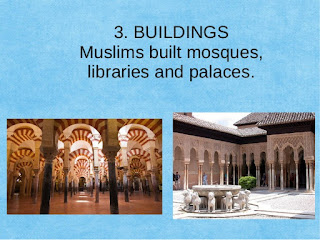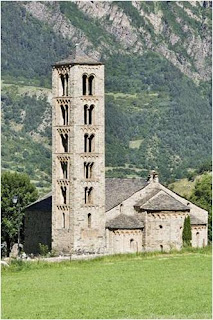We are starting to learn about the Middle Ages in Spain. A very long period that lasted from the 6th century to the 16th century
WATCH THESE VIDEOS TO LEARN MORE ABOUT THE MIDDLE AGES:
In the late third century AD the Roman Empire was showing signs of its coming collapse. In 410 AD, the Suevi and the Vandals, Germanic tribes, were forced into the Iberian Peninsula . These were followed by the Visigoths.
Visigoths gradually expanded their influence into Iberia eventually setting up their capital in Toledo during the reign of Leovigild.
Although the Visigoths were very different people to the Romans, they left behind a legacy of very decorative, often gaudy, jewellery but their language had a negligible influence on the natives because they didn’t mingle with them much. They tended to keep the same Roman institutions and legal code and traded with Mediterranean countries to keep contacts close. Their most obvious effect was the depopulation of cities as people moved to the countryside where a kind of feudal system was in place.
In 587AD, Reccared, the Visigothic king in Toledo, converted to Catholicism from the Arian Christianity he had previously worshipped and this led to a movement to unify the various religions that existed in the land at the time. The Council of Lerida in 546AD had tried to bring the churches more under the influence of Rome but there were still regular revolts from members of the nobility and rogue bishops.
In AD 711, Muslims from North Africa invaded Visigoth Spain. After the Battle of Guadalete, in which the Visigoths were defeated, Muslim armies continued the conquest. In just a few years they conquered most of the Iberian Peninsula and the Balearic Islands. The only remaining Christian territory was in the north of the peninsula. The Muslims called their conquered territory Al-Andalus. At first, Al-Andalus was a province that depended on the Caliph of Damascus.
Then, in 756, Abd al-Rahman I established the Emirate of Córdoba and proclaimed himself emir.
In AD 929, Al-Andalus became independent. Abd al-Rahman III established the Caliphate of Córdoba. He was the first caliph and the greatest ruler of Al-Andalus.
The society of Al-Andalus was very diverse and consisted of
people with different religions.
●The Muslims were the most powerful group. They owned
the best land and were in charge of the government.
●The Muladi were Christians who converted to Islam.
Some of them followed the Muslim religion to avoid paying
taxes.
●The Mozarabs were Christians who kept their own religion
but adopted Muslim customs.
●The Jews were a minority but they played an important
role in politics, commerce and art. They lived in separate
districts called juderías.
The Muslims of Al-Andalus were respectful of other people’s
beliefs. They allowed Christians and Jews to practise their
religions. Muslims, Christians and Jews often lived peacefully in Muslim cities.
Al-Andalus society consisted of three religious groups:
Muslims, Christians and Jews.
Most people in Al-Andalus lived in walled towns and cities.
Their main activities were crafts and trade. The medina,
where the craftspeople lived, and the market place, called the
zoco, were in the centre of the city. People prayed in a
mosque, or mezquita. Also inside the city walls, there was
usually a fort called an alcazaba and a fortified palace called
an alcázar. The cities were surrounded by fields where
farmers grew cereals, olives and grapes.
In the 11th century, Al-Andalus was divided into small
independent states called taifas.
Legacy of Al-Andalus
-The Muslims gave a lot to Spain. Perhaps the most important contribution from the people of Al-Andalus was their knowledge.
-They introduced paper, the compass and Arabic numerals, a numerical system which was at this time revolutionary due to its inclusion of the number zero.
-They also built libraries and established universities. They
built important buildings too.
built important buildings too.
-The Muslims also developed new methods of irrigation and
introduced new crops, such as rice, oranges and aubergines
or eggplants.
introduced new crops, such as rice, oranges and aubergines
or eggplants.
RECONQUISTA
The Reconquista began just after the Muslim conquest in the 8th century and finished with the conquest of the Kingdom of Granada in 1492.Stages of the Reconquista
 -Between the 8th and 10th centuries, the Christians from the north of the Iberian Peninsula created small kingdoms that were independent of Al-Andalus. In AD 722, don Pelayo, the ruler of the Kingdom of Asturias, defeated the Muslim army at the Battle of Covadonga. This victory marked the beginning of the Reconquista.
-Between the 8th and 10th centuries, the Christians from the north of the Iberian Peninsula created small kingdoms that were independent of Al-Andalus. In AD 722, don Pelayo, the ruler of the Kingdom of Asturias, defeated the Muslim army at the Battle of Covadonga. This victory marked the beginning of the Reconquista.-In the 11th century, Al-Andalus was divided into small independent states called taifas. The taifas were in constant conflict, which helped the Christians from the north expand into the south and reconquer Muslim territories. In 1085, Alfonso VI, the king of León and Castilla, conquered Toledo.
Alfonso X El Sabio Alfonso X, was born in Toledo, in the 13th century A.D., and he was king of Castile and Leon. As a warrior king, he led his fierce armies against the Moorish occupation, and regained many lands for the Christians, but this was not his most important achievement. He was above all, a highly educated statesman who promoted the arts and learning in his kingdom. He was a writer himself, and composed the Cantigas, which were songs about The Virgin Mary. He also created the Toledo School of Translators, where scholars from the three cultures, Christian, Jewish, and Muslim, translated important works of Science, History, and The Arts. His promotion of the arts and culture granted him the nickname of “The Wise Man”.
-In 1469, king Fernando II of Aragón and queen Isabel I of Castilla married and united their two kingdoms creating one powerful Christian Kingdom. In 1492, the Christians finally conquered the Kingdom of Granada
Rodrigo Díaz, or El Cid, was one of the military leaders of the Reconquista. The oldest epic poem in the Spanish language Cantar de mio Cid is based on the life of this hero.
El Cid Campeador’s real name was Rodrigo Díaz de Vivar. He was a Castilian nobleman who was born in Burgos in the 11th century A.D. He was a military leader who was exiled by the king of Castile, Alfonso VI, under accusations of treason. But El Cid didn’t give up on his loyalty to the king, and he conquered Valencia from the Moors. This granted him the King’s forgiveness, and he was made governor of the newly reconquered land. He became so famous and popular in his time, that the minstrels composed an epic poem about him: El Poema de Mio Cid. The minstrels travelled from town to town singing and telling stories and poems. This poem narrates the adventures and heroic feats carried out by Rodrigo Diaz de Vivar. It was written in the 13th century and it is considered the first written poem in Castilian language.
Feudalism was a hierarchical social system that was used in the Middle Ages. Medieval society consisted of the king and four other groups
The nobles were loyal to the king. They were very rich and lived in castles.
Knights fought in the nobles’ armies and the nobles gave them land.
The clergy were religious people, such as priests, monks and nuns. Monks lived in monasteries and nuns lived in convents.
Peasants lived in villages near the nobles’ castles. Most peasants were serfs, which means they weren’t free people. They had to work on the nobles’ land and give them part of their crops. If a noble decided to sell land, he sold the serfs along with it.
Medieval cities or Christian Cities
In the 12th century the trade started to expand. As a result, cities grew and became more important. New cities were usually built near trade routes, such as roads and rivers.
Medieval cities were protected by a large wall. Townspeople and travellers had to enter and leave the city through fortified gateways
The streets were very narrow and the wooden houses were close together, which meant fire was a great danger. Diseases spread very quickly because people lived in bad conditions, and there was no running water in the houses and no sewage system
Important buildings, such as the cathedral and the town hall, were in the main square. The main square was also where the market and fairs took place. Craftspeople and artisans made products which were bought and sold by merchants.
The majority of people who lived in cities were merchants and craftspeople. Craftspeople who did the same type of work joined together to form guilds. These guilds became very powerful in the city. They controlled the prices of the products and the quality of work
ART IN THE MIDDLE AGES IN THE IBERIAN PENINSULA
Spanish medieval art is varied due to the influence of the different civilisations that lived in the Iberian Peninsula during the period, especially the Christians and Muslims. We can identify four main styles of medieval art in Spain: Islamic, Romanesque, Gothic and Mudéjar.
ISLAMIC STYLE
After the Muslim conquest of the Iberian Peninsula, Spanish artists worked in the Islamic style during the 11th century.
Palacio Alfajería, ZaragozaMezquita de Córdoba
Characteristics:
●horseshoe arches
●harmonious proportions
●mosaics
●patterns using repetition of geometric and natural motifs
●domes
●open courtyards
●no sculptures
●bright colours
Romanesque style
Artists in Christian territories during the 11th and 12th centuries used the Romanesque style.
Catedral de Jaca
Characteristics:
●small windows
●rounded arches
●thick walls
●low structures
dark inside
San Clemente de Tahull, Lérida
Gothic style
Characteristics:
●big stained-glass windows showing scenes from the Bible
●pointed arches
●tall structures
●rose windows
Mudéjar style
 In the Christian Kingdoms, Islamic style was mixed with the Romanesque or Gothic styles creating a new type of art called Mudéjar. This style developed in the 12th century
In the Christian Kingdoms, Islamic style was mixed with the Romanesque or Gothic styles creating a new type of art called Mudéjar. This style developed in the 12th centuryAlcázar de Sevilla
 Features:
Features:
Geometric character,
distinctly Islamic,
elaborate tilework,
brickwork,
wood carving,
plasterwork
ornamental metals.
complicated tiling patterns.
 Features:
Features:Geometric character,
distinctly Islamic,
elaborate tilework,
brickwork,
wood carving,
plasterwork
ornamental metals.
complicated tiling patterns.
Catedral de Teruel
REMEMBER THE IMPORTANT DATES OF THIS FANTASTIC UNIT AND WHAT HAPPENED IN THOSE YEARS:
- 711: Muslims invaded the Iberian Peninsula and they defeated the Visigoths in the Battle of Guadalete.
- 722: the ruler of the Kingdom of Asturias, Don Pelayo, defeated the Mulsim army at the Battle of Covadonga.
- 756: Abd al-Rahman I established the Emirate of Córdoba and proclaimed himself emir.
- 929: Al-Andalus became independent and Abd al-Rahman III established the Caliphate of Córdoba. He was the first caliph and the greatest ruler of Al-Andalus.
- 1085: Alfonso VI, the king of León and Castilla, conquered Toledo.
- 1212: the Kingdoms of Portugal, Castilla, Aragón and Navarra combined their forces and defeated the Muslims at the Battle of Las Navas de Tolosa.
- 1469: Fernando II of Aragón and Isabel I of Castilla got married and united their two kingdoms.
- 1492: the Christians finally conquered the Kingdom of Granada. This was the end of the Reconquista.
























Comments
Post a Comment